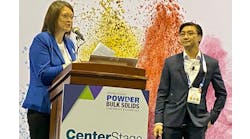Light flashed innocently from a small dust cloud. A pressure wave from this tiny ignition suddenly exploded. The cloud swallowed an operator nearby, who began to choke as it seared his nose and throat. A larger explosion, like a flash bulb, erupted out of nowhere. He was thrown across the room and killed by the pressure wave from the chain reaction resulting from the dust explosion. Pretty grim.
Combustible dust demands respect. The U.S. Chemical Safety and Hazard Investigation Board cited 119 deaths from dust explosions from 1980–2005. (Dust also can pose a variety of other risks, as noted in “Dust Never Sleeps.")
I’ve broken this subject into five aspects: 1) understanding the risk; 2) identifying the risk; 3) classifying the risk, i.e., creating electrical-area-classification drawings; 4) mitigating the risk; and 5) establishing and maintaining a structure of vigilance.
This column focuses on the first two aspects. A key resource is NFPA 499, “Recommended Practices for the Classification of Combustible Dusts and of Hazardous (Classified) Locations for Electrical Installations in Chemical Process Areas,” 2021 ed., issued by the National Fire Protection Association (NFPA), Quincy, Mass.
Let’s now turn to definitions.
A combustible dust is one identified by the U.S. Occupational Safety and Health Administration and the NFPA as providing enough heat to ignite and sustain a flame. Many factors affect combustion: moisture, particle size, degree of dispersion, surface condition of the particles, oxygen presence, etc. Typically, testing begins with a 200-g sample for a go/no-go screening involving pre-treatment to sift 200-mesh particles (95% efficiency) and dry to less than 5% moisture. If that shows potential risk, then other tests are performed to determine explosive pressure (Kst, Pmax), minimum ignition energy (MIE), minimum autoignition temperature (MAIT), minimum explosive concentration (MEC), hot surface ignition temperature (HSIT), limiting oxygen concentration (LOC), resistivity and charge relaxation, and chargeability. Of course, testing at the conditions of your dust, i.e., particle size, etc., will yield the most realistic results. Chapter 2 of NFPA 499 presents several useful references for tests and definitions.
NFPA 499 identifies four groups of combustible dusts: E — metal dusts, e.g., aluminum, zirconium, beryllium, magnesium (e.g., Kst > 300); F — carbon dusts with more than 8% volatile (flammable) liquid, e.g., coke dust, wood dust, sugar, sulfur (e.g., 0 < Kst < 200); G — dusts from chemical, food or pharmaceutical manufacturing, such as those from plastics, cellulose and grains as well as fibers longer than 500 µ; the fourth group generally doesn’t occur in the chemical industry.
NFPA 499 Section 3.3.6 describes a “hybrid mixture.” This is “an explosible heterogeneous mixture comprising gas with suspended solids or liquid particulates” under the following criteria: ≥ 10% of the lower explosive limit (LEL) for the volatile and ≥ 10% of the MEC for the combustible solid. A hybrid can pose a magnitude greater danger than any of its components. The lesson here is that, though standards and textbook references are helpful, safety is situational: count on measurements.
[pullquote]
For example, as a researcher on rocket propellants for the U.S. Air Force, I worked with a contractor to design and build a zirconium particle grinding factory to replace one in San Francisco that blew up, also taking out a neighboring noodle factory. The new plant was a step forward, designed to produce a strict particle-size distribution because even a small percentage of fine particles would ignite in air and destroy the rocket containing them. This underscores that particle distribution is critical to safely handling dusts. The finer the dust, the lower its layer ignition temperature and the easier it is to ignite.
NFPA 499 barely touches on two other dangers with dust well known to safety experts in the business: 1) dust can insulate an electric motor or, contrarily, conduct electricity where it isn’t supposed to, resulting in over-heating, fires and even ignition; and 2) some dusts can melt and behave more like flammable or even combustible liquids than solids. In the second case, NFPA 499 recommends determining if the cloud ignition temperature is lower than the layer ignition temperature.
We’ll get more into identifying combustible dust risk in the next column, and then selecting proper electrical area classification.
For more insights on dealing with combustible dusts, check out CP’s ongoing “Combustible Dust Round Table” webinars at www.chemicalprocessing.com/webinars.



